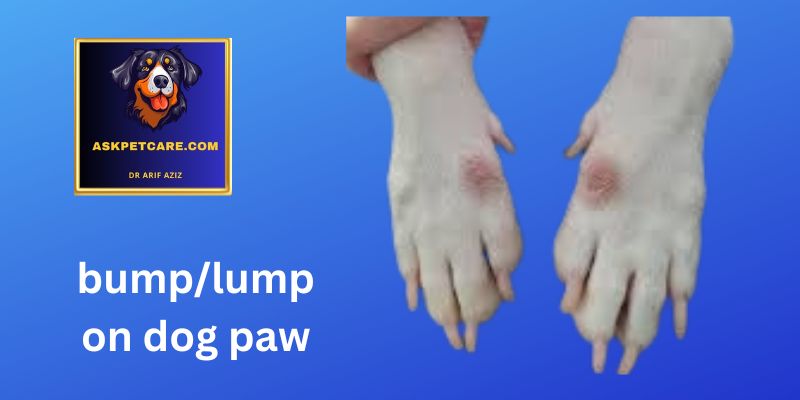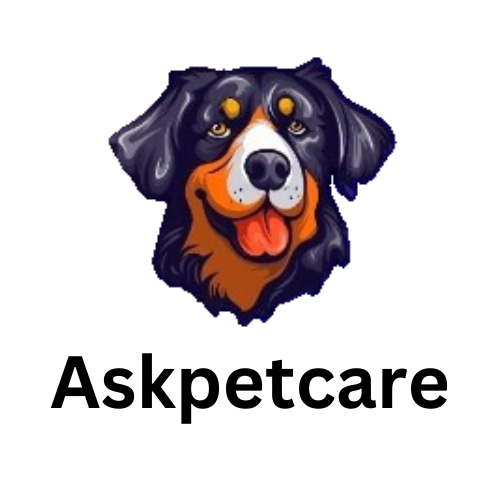Hello, dog lovers I am Dr. Arif Aziz in this blog post lump on Dog Paw, I will explain what a is lump and its causes, signs, and symptoms in detail. Identifying lumps or swellings on your dog’s paw is critical for their health and well-being. Here are some things to look for:
Size and Texture: Lumps can be small bumps or larger masses, and they might feel soft or firm.
Coloration: Depending on what’s causing the lump, it might be pink, red, black, or blend in with the skin. Color changes could mean something is going on.
Location: These lumps can pop up anywhere on the paw, from between the toes to the top of the paw pads. Some are easy to see, while others hide under fur or between the toes.

Pain or Discomfort: If your dog seems bothered by the lump, they might lick or chew at it, limp, or avoid putting weight on that paw.
Changes Over Time: Keep an eye on any changes in the lump’s size, color, or texture. Documenting these changes helps the vet figure out what’s going on.
It’s a good idea to check your dog’s paws regularly as part of your grooming routine. Here’s why it matters:
Early Detection: Regular checks help you catch any problems early. Getting treatment quickly can prevent issues from getting worse.
Preventing Discomfort: Finding lumps early means your dog won’t have to deal with discomfort or pain for long. Treating problems early can help them feel better sooner.
Keeping Paws Healthy: Checking regularly lets you take care of any minor issues before they become big problems. Plus, keeping paws clean helps prevent infections and irritations.
In short, by checking your dog’s paws regularly, you can spot any potential issues early and take steps to keep them healthy and happy.
| Characteristics | Description |
| Size and Texture | Lumps can be small or large, and they might feel soft or firm. |
| Coloration | The lump’s color can vary from pink, red, and black to blend in with the skin. |
| Location | Lumps can appear anywhere on the paw, including between toes or on paw pads. |
| Pain or Discomfort | Signs of discomfort may include licking, chewing, limping, or avoiding putting weight on the paw. |
| Changes Over Time | Monitor changes in size, color, or texture of the lump for early detection and treatment. |
Checking your dog’s paws regularly is essential for early detection and intervention. It helps prevent discomfort and promotes overall paw health.
Various things can make a lump on dog paw, and each one can affect the dog differently: Lump on Top of Dog’s Paw:
Injuries or Trauma:
Dogs can hurt their paws by stepping on sharp stuff, on rough ground, or by accident during play. This can make the paw swell up, bruise, or form lumps because of damage or swelling.
Allergies or Insect Bites:
Sometimes, dogs get swollen or itchy paws from things like pollen, grass, or insect bites. Things like fleas, ticks, bees, or spiders can also cause lumps or bumps on the paw.
Infections, Including Bacterial or Fungal:
Dogs can get infections on their paws from germs in the environment or if they already have skin issues. These infections can make the paw red, and swollen, and might have pus or bumps. Fungal infections, like ringworm, can also make circular lumps or bumps on the paw pads.
Tumors or Cysts:
Sometimes, lumps grow on a dog’s paw because of genetics, getting older, or being exposed to harmful stuff. These lumps might be harmless or dangerous, and they can feel like firm, round bumps under the skin.
If you like to read more click below
bump-on-dog-paw-dr-understanding
dog-paw-keratoma-dr-practical-tips-and-tricks
It’s super important for pet owners to go to the vet to figure out what’s causing lumps on their dog’s paws. Here’s why:
| Causes | Description |
| Injuries or Trauma | Dogs can hurt their paws by stepping on sharp stuff, on rough ground, or by accident during play. |
| Allergies or Insect Bites | Dogs might get swollen or itchy paws from things like pollen, grass, or insect bites. |
| Infections, Bacterial or Fungal | Dogs can get infections on their paws from germs in the environment or if they already have skin issues. |
| Tumors or Cysts | Lumps might grow on a dog’s paw because of genetics, getting older, or being exposed to harmful stuff. |
Going to the vet is super important to figure out what’s causing the lumps and to make sure the dog stays healthy and happy.

When you see the lump on your dog’s paw, there are some signs to look out for that might tell you something’s up:
Swelling or Inflammation: The area around the lump might get red, warm, or puffy. This means there’s a reaction happening, like an infection or injury.
Pain or Discomfort: Your dog might feel sore or uncomfortable around the lump. They might lick or chew at it to try to feel better, which can make things worse.
Changes in Behavior: Keep an eye out for changes in how your dog moves. They might limp or avoid putting weight on the paw with the lump.
It’s really important to keep an eye on your dog and see the vet if you notice any of these signs:
When you see a lump on a dog’s paw, vets may do tests to find out what’s going on. Here’s what they might do:
Physical Examination:
The vet will look closely at the lump, feel it, and check its size, shape, color, and texture. This helps them get an idea of what’s going on and decide what other tests might be needed.
Fine Needle Aspiration (FNA):
This test is like taking a tiny sample from the lump using a thin needle. The vet looks at the cells under a microscope to see if there’s anything unusual. It helps them figure out if the lump is harmless or something more serious.
Biopsy:
If the FNA doesn’t give enough information, the vet might recommend a biopsy. This means taking a small piece of tissue from the lump and sending it to a lab for closer examination. It helps them know exactly what’s causing the lump and how to treat it.
Why these tests are important:
Finding the Right Diagnosis: These tests help vets figure out what’s causing the lump so they can treat it properly.
Personalized Treatment: Once they know what’s going on, vets can make a treatment plan that’s just right for the dog.
Understanding the Outlook: Knowing more about the lump helps vets and pet owners understand what might happen next and make treatment decisions.
These tests help vets figure out what’s causing the lump on the dog’s paw so they can treat it properly and understand what might happen next.
When addressing lumps on a dog’s paw, the treatment options depend largely on the underlying cause identified through diagnostic procedures. Veterinarians may recommend various treatment approaches tailored to the specific diagnosis and the individual needs of the dog. Here are the common treatment options available:
Medical Management:
Medical management involves the use of medications to address underlying causes such as infections, inflammation, or allergic reactions. Depending on the diagnosis, veterinarians may prescribe antibiotics to treat bacterial infections, antifungal medications for fungal infections, or anti-inflammatory drugs to reduce swelling and discomfort.
Anti-inflammatory medications such as corticosteroids or non-steroidal anti-inflammatory drugs (NSAIDs) may also be prescribed to alleviate pain and inflammation associated with lumps on the dog’s paw.
Pet owners need to administer medications as directed by the veterinarian and adhere to the prescribed dosage and duration of treatment to ensure optimal efficacy and minimize the risk of side effects.

Surgical Removal of Tumors or Cysts:
In cases where lumps on the dog’s paw are due to tumors, cysts, or other growths, surgical removal may be necessary to alleviate discomfort, prevent further growth, and reduce the risk of complications. Surgical excision involves the complete removal of the lump and surrounding tissue to ensure complete eradication of abnormal cells.
Before surgery, veterinarians may perform pre-operative tests to assess the dog’s overall health status and evaluate the extent of the lump. Surgical removal may be performed under general anesthesia to ensure the dog’s comfort and safety during the procedure.
Following surgery, pet owners should follow the veterinarian’s post-operative care instructions carefully, including wound care, medication administration, and activity restriction, to promote optimal healing and prevent complications.
Topical Treatments for Skin Conditions:
In cases where lumps on the dog’s paw are associated with skin conditions such as dermatitis, allergies, or infections, topical treatments may be prescribed to alleviate symptoms and promote skin health. Topical treatments may include medicated shampoos, sprays, ointments, or creams designed to reduce inflammation, soothe itching, and promote healing.
Pet owners should apply topical treatments as directed by the veterinarian and follow instructions regarding frequency, duration, and proper application techniques to achieve optimal results.
treatment options for lumps on a dog’s paw may include medical management, surgical removal of tumors or cysts, and topical treatments for skin conditions. Pet owners should collaborate closely with their veterinarian to develop a comprehensive treatment plan and ensure the best possible outcome for their furry companion.
Preventing the development of lumps or bumps on a dog’s paw is an important aspect of maintaining their overall health and well-being. Here are some preventive measures that pet owners can take to help keep their dog’s paws healthy:
Keeping Paws Clean and Free from Debris:
Regularly inspect your dog’s paws for any signs of debris, dirt, or foreign objects such as thorns, rocks, or burrs. Clean your dog’s paws with a damp cloth or gentle pet-safe wipes to remove any dirt or debris that may accumulate during walks or outdoor activities.
Keeping the paw area clean reduces the risk of irritation, infections, or injuries that can lead to the development of lumps or bumps.
Providing Proper Foot Care:
Trim your dog’s nails regularly to prevent overgrowth, which can cause discomfort and affect their gait. Long nails can also snag on surfaces and increase the risk of injury or trauma to the paw pads.
Maintain your dog’s paw pads by keeping them moisturized with pet-safe paw balms or moisturizers. Dry, cracked paw pads are more susceptible to irritation and injury.
During cold weather or when walking on hot pavement, consider using protective booties to protect your dog’s paws from extreme temperatures, abrasive surfaces, or harmful substances.
Minimizing Exposure to Potential Allergens or Irritants:
Identify and minimize exposure to potential allergens or irritants that may trigger allergic reactions or skin sensitivities in your dog. Common allergens include pollen, grass, weeds, certain plants, and household chemicals.
When walking your dog outdoors, avoid areas with known allergens or chemical treatments, such as pesticides or herbicides. Rinse your dog’s paws with water after walks to remove any potential allergens or irritants.
Encouraging Regular Veterinary Check-Ups:
Schedule regular veterinary check-ups for your dog to monitor their overall health and well-being. Veterinarians can perform thorough physical examinations, assess paw health, and address any concerns or abnormalities promptly.
Regular veterinary visits also allow for early detection and intervention of any underlying health issues that may predispose your dog to develop lumps or bumps on their paws.
By following these preventive measures, pet owners can help reduce the risk of developing lumps or bumps on their dog’s paws and promote overall paw health and comfort.
Is my dog lump hard or soft?
If you’re wondering whether your dog’s lump is hard or soft, here’s what to look for:
Hard Lump: Feels firm, like a solid mass. It doesn’t squish much when you touch it.
Soft Lump: Feels squishy or movable, like there’s fluid inside. It might change shape when you press on it.
Understanding if the lump is hard or soft can give you clues about what might be causing it. If you’re unsure or worried, it’s best to have your vet check it out. They can tell you more about what’s going on and what to do next.
Growth on dog paw :
Let’s delve into more detail about the difference between a lump and a bump on a dog’s paw and their respective treatments:
Lump on Dog’s Paw:
Characteristics: A lump is typically a larger, more solid mass that may feel firm or hard to the touch. It can vary in size and shape, appearing round or irregular.
Causes: Lumps on a dog’s paw can result from various factors such as tumors, cysts, abscesses, or foreign body reactions. Tumors may be benign or malignant and may require different treatment approaches.
Treatment:
Surgical Removal: If the lump is causing discomfort, hindering movement, or is suspected to be cancerous, surgical removal may be recommended. This involves excising the lump and surrounding tissue to prevent regrowth.
Medication: In cases where the lump is caused by inflammation or infection, veterinarians may prescribe medication such as antibiotics or anti-inflammatory drugs to alleviate symptoms and promote healing.
Biopsy: For suspicious lumps, a biopsy may be performed to obtain a tissue sample for analysis and confirm the diagnosis. This helps determine the appropriate treatment plan and prognosis.

Bump on Dog’s Paw:
Characteristics: A bump is usually smaller and softer compared to a lump. It may feel squishy or movable and may appear fluid-filled. Its color may range from red to white.
Causes: Bumps on a dog’s paw can arise from various factors including insect bites, allergic reactions, cysts, or localized infections such as abscesses.
Treatment:
Drainage: If the bump is a localized abscess filled with pus, the veterinarian may need to drain it to alleviate discomfort and prevent further infection. This involves making a small incision to release the accumulated fluid.
Antibiotics: In cases where the bump is caused by bacterial infection, antibiotics may be prescribed to clear the infection and prevent recurrence.
Observation: Some bumps may resolve on their own without intervention. However, it’s important to monitor the bump closely and seek veterinary attention if it persists, grows in size, or causes discomfort.
Importance of Veterinary Evaluation:
Regardless of whether it’s a lump or a bump, any unusual growth on your dog’s paw should be evaluated by a veterinarian. They can conduct a thorough examination, perform diagnostic tests if necessary, and recommend the most appropriate treatment based on the underlying cause and your dog’s overall health.
Lump on Top of Dog’s Paw:
Characteristics: A lump on the top of a dog’s paw could arise from various causes, including trauma, infection, cysts, tumors, or allergic reactions. The lump may vary in size, shape, and texture, and it may or may not be associated with pain or discomfort.
Sudden Lumps on Dog Under Skin:
Characteristics: Sudden lumps appearing under a dog’s skin can be concerning and may indicate various health issues. These lumps may vary in size, shape, and texture and may or may not be associated with pain or discomfort.
What is a bump?
A bump is a small, raised area that can be observed on the skin’s surface or within the body’s tissues. It stands out from the surrounding skin and can be felt by running fingers over the affected area. Bumps may vary in size, ranging from very small to larger protrusions.
What is a lump?
A lump is a larger and more prominent swelling or mass that forms either under the skin or within the body’s tissues. It is often more noticeable than a bump due to its size and can be felt when touched or palpated.
| Feature | Lump | Bump |
| Size | Typically larger | Generally smaller |
| Location | Under the skin or within body tissues | On the skin’s surface or tissues |
| Texture | Firm or hard | Soft or squishy |
| Appearance | More noticeable | Raised area |
| Cause | Inflammation, infection, trauma, cysts, tumors | Minor injuries, insect bites, allergic reactions, localized infections |
| Sensation | May or may not be painful | May be tender or painful to touch |
This table summarizes the key differences between lumps and bumps based on their size, location, texture, appearance, causes, and sensation.
- “The Complete Dog Owner’s Manual” by Dr. Bruce Fogle
- “The Ultimate Guide to Dog Care: Everything You Need to Know to Keep Your Dog Happy and Healthy” by Amy Marder and Andrew Luescher
3. “The Veterinarians’ Guide to Natural Remedies for Dogs: Safe and Effective Alternative Treatments and Healing T

1 thought on “Lump on Dog Paw. Dr. Understanding and Addressing”